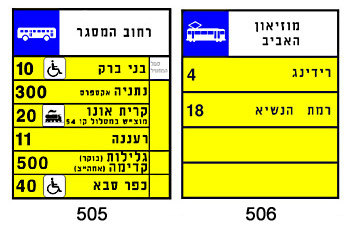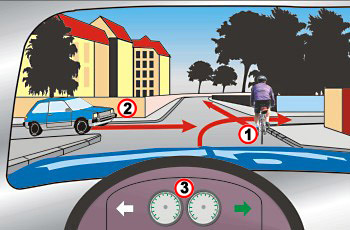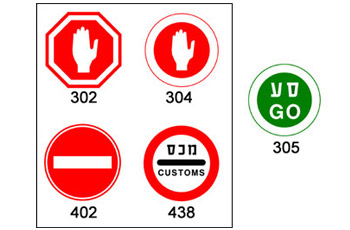Question:1
The white vehicle’s driver is merging into traffic. how would you behave?

Category : Safety
Question:2
What should be the initial actions taken by a driver after entering the vehicle and before starting to drive?
Category : Safety
Question:3
“Reasonable speed” is a speed:
Category : Rules and Regulations
Question:4
When is it permitted to perform an emergency stop?
Category : Safety
Question:5
What are you required to do when the following road marking appears on your left?

Category : Traffic Signs
Question:6
What are we required to see in the outer side mirrors of the vehicle?
Category : Safety
Question:7
What is the meaning of the following traffic sign?

Category : Traffic Signs
Question:8
Which types of taxi ride are permitted under a license issued by the Controller of Road Transport?
Category : Rules and Regulations
Question:9
Is the driver of a route service bus obliged to announce the stations along the route?
Category : Rules and Regulations
Question:10
When is it permitted to turn on the fog lights?
Category : Rules and Regulations
Question:11
What are you required to do according to the following road sign?

Category : Traffic Signs
Question:12
Why are you required to be more careful while driving after dark?
Category : Safety
Question:13
What might be the effect of sand scattered on the road?
Category : Safety
Question:14
What is the correct manner of making a right-turn?
Category : Rules and Regulations
Question:15
What is the difference between the following signs?

Category : Traffic Signs
Question:16
What should a driver do when one of the vehicle’s two headlights is malfunctioning during the night?
Category : Rules and Regulations
Question:17
What is the function of a vehicle’s retarder?
Category : Rules and Regulations
Question:18
How would you get the attention of the overtaken vehicle’s driver while overtaking on a freeway (motorway)?
Category : Safety
Question:19
When is it permitted to use the “white reversing light”?
Category : Rules and Regulations
Question:20
How should you behave when approaching the road section described in the following picture?

Category : Safety
Question:21
What are we required to ensure before starting to drive?
Category : Safety
Question:22
What is the statutory obligation to slow down which applies to drivers?
Category : Rules and Regulations
Question:23
When you apply the brake pedal during an emergency braking:
Category : Safety
Question:24
How should a driver conduct himself when another vehicle suddenly emerges in his driving lane from the opposite direction, heading towards him?
Category : Rules and Regulations
Question:25
Is it permitted to stop, stand or park a vehicle on a freeway (motorway)?

Category : Rules and Regulations
Question:26
How should you (vehicle no. 3) behave while you turn right in the following intersection?

Category : Rules and Regulations
Question:27
Which traffic sign is likely to appear before traffic sign 305?

Category : Traffic Signs
Question:28
Are you obliged to vacate your bus seat for a handicapped person, when bus seats have been marked and reserved in advance?
Category : Rules and Regulations
Question:29
What is the meaning of alternating red-white colored curbstones?

Category : Traffic Signs
Question:30
If a vehicle is lawfully photographed while committing an offence, who of the following is held responsible for the offense?
Category : Rules and Regulations

